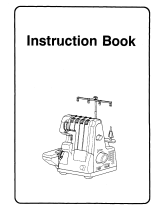
5
PREPARATION
Names of Parts...................................................8
Standard Accessories ........................................8
Connecting the Machine to the Power Supply
.....10
Controlling Sewing Speed................................10
For Your Safety ................................................10
How to Turn the Handwheel.............................12
Opening and Closing the Side Cover...............12
Opening and Closing the Looper Cover...........12
The Position of Thread Guide Bar....................14
Attaching the Spool Holder Cap and Net
............14
Changing Needle..............................................16
Raising or Lowering the Presser Foot..............16
Removing the Presser Foot .............................18
Attaching the Presser Foot...............................18
Adjustment of Foot Pressure............................18
Adjustment of Stitch Length .............................20
Adjustment of Differential Feed Ratio ..............20
To Deactivate the Upper Knife .........................22
To Activate the Upper Knife .............................22
Adjustment of Cutting Width.............................24
Adjustment of Needle Plate Setting Knob........26
Threading the Machine.............................. 28~46
• Threading the Lower Looper .....................30
• Threading the Upper Looper .....................36
• Threading the Needle on the Right ...........40
• Threading the Needle on the Left..............44
TEST STITCHING
Starting Sewing ................................................48
Finishing Sewing ..............................................48
Sewing Continuously........................................48
How to use Guide Lines ...................................48
Securing Ends ..................................................50
Thread Tension (4 threads)..............................52
Threading the Machine (3 threads) ..................56
Thread Tension (3 threads)..............................58
Thread and Needle Chart.................................60
TABLE OF CONTENTS
ROLLED HEMMING, PICOT EDGING AND
NARROW HEMMING
Machine Setting and Thread, Fabric and
Range of the Tension Dial................................62
Thread Tension ................................................66
For Better Results ............................................68
DECORATIVE OVEREDGING
Thread and Fabric ............................................70
Machine Setting................................................70
GATHERING
Thread and Fabric ............................................70
Machine Setting................................................70
PIN TUCKING
Thread and Fabric ............................................72
Machine Setting................................................72
Sewing..............................................................72
CARE OF YOUR MACHINE
Replacing the Upper Knife ...............................74
Cleaning Upper Knife Area ..............................74
Replacing the Light Bulb ..................................76
Cleaning the Feed Dog ....................................76
Oiling the Machine............................................78
Carrying the Machine .......................................78
Troubleshooting................................................80
OPTIONAL PARTS .......................................84




















